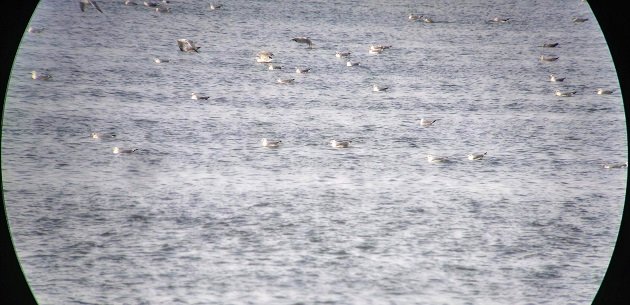
Do you ever feel that you do not know your birds anymore? I had that feeling today.
Usually I do not start gulling before late October, but finding myself cut off from most of my local patches, I went gulling today, probably my earliest beginning of the gulling season at Ada Huja promenade, along the Danube inside Belgrade – ever.
There were the usual 2,500 large gulls. I scoped them, all white and grey and told myself: I have no clue what am I looking at!
I haven’t been gulling since last winter. I always plan to follow gulls’ spring migration at the city landfill, but as spring gets warmer, songbird migration more pronounced and the landfill more aromatic, I give up and never return before the next winter.
And so I was observing this large flock (for big gulls, at least) and felt – I know nothing of gulls at all! Panic attack! But then I calmed down and looked again.
Ok, steep forehead, strong beak – I am looking at Yellow-legged Gulls. Young gull wearing sun glasses? Also Yellow-legged. Calm down. You did this before.
Scanning the flock in the middle of the 1,000 metre wide river. That one has a hood! Yellow beak, red spot – adult, and it has very visible hood! It is a European Herring Gull, supposedly a rarity here, but since it is merely a two-splits-old species, more likely a regular, if ill-numbered and overlooked species. I found my first in Serbia only last winter, but that was a result of a decision: you have to find it this winter. And so I did. The first day of gulling, the first “rare” species.
Okay, let’s check that flock again… That one doesn’t have a steep forehead? A Caspian Gull. Those few over there seem darker. Only the shadow or are some of them really darker? One takes flight. And in flight, shows its wings. The upperside is almost black, yet the bird is not impressively huge – a Lesser Black-backed Gull, a rather uncommon species here. And it all comes back.
But the panic stays with me! In a few days, my new field guide arrives. How many gulls do you have over there, in Central America? I know that I am facing 900 birds and only three weeks to learn them!! God help me.
You will read about that panic later…











Not many gulls to worry about in Costa Rica, instead you have to learn 50 hummingbirds, dozens of flycatchers, and birds with odd names like foliage-gleaners and tuftedcheeks.
Gulling gives me anxiety! I just returned from a trip in the US to Delaware to bird and I said the same thing to myself several times while looking at hundreds (definitely NOT thousands) of gulls, “I have no clue what I’m looking at.” So I just photographed what I saw and now I’m dreading going through my photos. I probably would have fainted if I had to look at thousands of gulls.
The Birds of Costa Rica by Garriguez and Dean arrived the other day. At this stage I am focusing on climate, biomes and families, especially the New World families, rather than species.
Species will be the next step.
And, Costa Rica truly seems like a step beyond… the future 😉
I deliberately posted that lousy cover photo where you can barely see the birds on the water, some 2,000 feet away, to show how it all looks in the field.
But, the true is, I use that lower magnification (25x) to scan the flock for odd birds, then I zoom on them, 60x, so yes, I can see much more. Yet, they are frustrating.
That day, when I found the European Herring Gull – and I think that Serbia has less than 5 observations of this new and more northerly species – the entire flock took flight after some time for no reason whatsoever! And only minutes before they tolerated smaller boats, even barge trains to sail right through the flock without any reaction.
Gulling is easy. Hire a guide, let them worry about it.
Not many guides around and those most knowledgeable of gulls are not in this city. So the most obvious solution would be to hire myself to worry over me. Which I did even before I was hired.